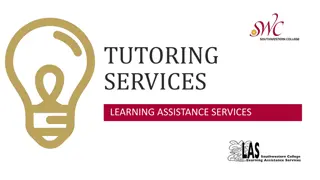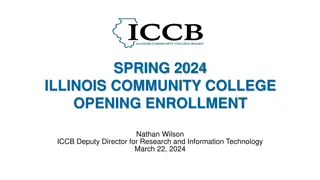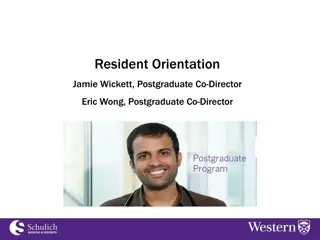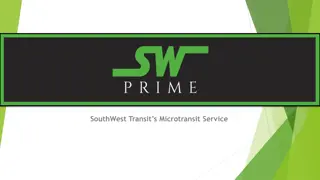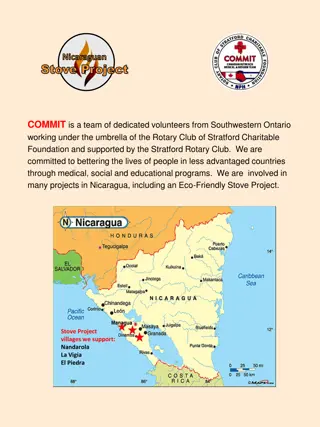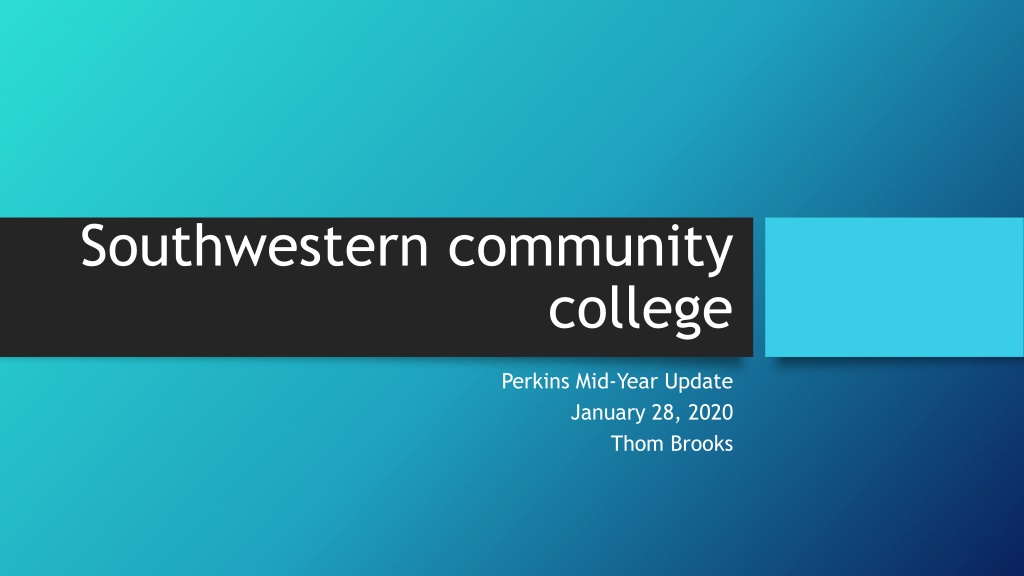
Mid-Year Updates on Perkins Programs at Southwestern Community College
Stay informed about the latest updates on Perkins programs at Southwestern Community College for enhancing academic, career, and technical skills of students. Budget updates, promising practices, and program evaluations are highlighted to showcase the college's commitment to providing quality education and professional development opportunities. Explore the initiatives taken to strengthen the academic success and industry relevance of CTE programs through innovative practices and technology integration.
Download Presentation

Please find below an Image/Link to download the presentation.
The content on the website is provided AS IS for your information and personal use only. It may not be sold, licensed, or shared on other websites without obtaining consent from the author. Download presentation by click this link. If you encounter any issues during the download, it is possible that the publisher has removed the file from their server.
E N D
Presentation Transcript
Southwestern community college Perkins Mid-Year Update January 28, 2020 Thom Brooks
Budget Updates and Promising Practices Voc Code 11 Strengthen the Academic, Career and Technical Skills of Students Voc Code 13 All Aspects of Industry Voc Code 14 Develop, Improve, or Expand the Use of Technology Voc Code 15 Professional Development Voc Code 17 Initiate, Improve, Expand, or Modernize CTE Programs Reserve Fund Allocation Program evaluation, modernization, and faculty development
Voc Code 11 Strengthen the Academic, Career and Technical Skills of Students Provide tutoring and learning support for CTE students Peer tutors, professional tutors, and lab tutors to support academic and technical skill development of CTE students Update: Tutor funds are being expended on schedule Promising Practice 86% course success rate for students participating in Perkins supported tutoring
Voc Code 13 All Aspects of Industry Expanding participation in work based learning in CTE programs Employ a PT work based learning coordinator with Perkins support Update: WBL coordinator funds are being expended on schedule Promising Practice Created electronic process for orientation, assessment, and documentation of WBL participation
Voc Code 14 Develop, Improve or Expand the use of Technology Provide workshops and consultations in distance learning technology to instructors Provide workshops in the use of classroom technologies Certify at 4 CTE distance learning courses as Exemplary or Distinguished each year Update: Instructional Technologist employed on January 1 Promising Practice Employed a new instructional technologist to train and support CTE faculty in the development of online courses and health simulations
Voc Code 15 Professional Development Provide discipline specific professional development for CTE instructors: Occupational Therapy Assistant Physical Therapy Assistant Provide professional development for WBL coordinator Update: Funds are being expended for monthly workshops; discipline specific PD is upcoming later in the Spring Promising Practice Provide monthly on-campus TOPs workshops in topics such as soft skill development, grading rubrics, and engaging students in collaborative learning
Voc Code 17 Initiate, Improve, Expand, or Modernize CTE Programs Provide funds for expansion of Welding program Equipment to support the physical and curriculum expansion of the WLD program Provide funds to modernize the Medical Sonography program Simulation Equipment Update: Orders are in process for all equipment Promising Practice Provide funds for collaborative project whereby Mechatronics students will create a Telepresence Robot for use by Health Sciences Students
Perkins Expansion Funds Expansion funds were directed support improved student outcomes in the Nursing program Evaluation of the Nursing program by nursing consultants Professional Development for Nursing faculty Modernization of equipment Update: evaluation and equipment purchases are complete. Professional development is scheduled later this spring. Promising Practice Use of expansion funds to concentrate on the evaluation and improvement of a specific CTE program: Nursing
Insights from the CLNAs Performed CLNA for Health Sciences and Automotive
Insights from the CLNAs - Automotive Course success rates of Native American (40%) and Black (70%) students are below that of other race/ethnic groups during 2018-19. While college-age students complete automotive credentials at above average rate compared to the overall SCC student body, this rate is much lower for high school CCP automotive students: 13%. Employment outlook data indicate that there are more job openings in the local service area than currently being served by the enrollment in the AAS program; 38 annual job openings (new and turnover) are projected, while 23 students were registered in the AAS program. This gap is wider on a regional level with an estimated 158 annual openings.
Insights from the CLNAs - Automotive This results from NCTower and SCC graduate survey data under- employment of graduates in a field that has been assessed as In- Demand: NCTower shows 71% employment in the year following graduation and graduate surveys indicate 46% employment. During 2018-19, 15 students enrolled in college-age automotive courses had taken high school automotive CCP courses with SCC. While this represents 38% of the college-age enrollment, it is approximately 15% of the annual CCP enrollment that subsequently enrolled in automotive at SCC upon high school graduation.
Insights from the CLNAs - Automotive Special populations students performed lower in all three categories (income, disability, unemployment) for EMS and Nursing SCC Health Science programs appear to have less ethnic and racial diversity than the overall SCC student body and the service area population: Health Science students are 87.6% white compared to 78.2% for entire SCC student body and 82.3% for the service area population. Minority students enrolled in the programs perform comparably, but fewer students enroll from the beginning.
Insights from the CLNAs Health Sciences Table 6: Program Enrollment and Job Openings Annual Job Openings Service Area % of Svc Area Openings Enrolled Annual Job Openings Regional % of Regional Openings Enrolled Program Enrollment Emergency Medical Science 26 35 37% 80 16% Health Information Technology 24 3 400% 27 44% Human Services Technology 42 18 117% 61 34% Medical Assisting 22 25 44% 198 6% Medical Laboratory Technology 20 7 143% 50 20% Medical Sonography 19 1 950% 12 79% Nurse Aide 3 119 1% 746 0% Nursing Associate Degree 74 70 53% 500 7% Occupational Therapy Assistant 28 2 700% 16 88% Phlebotomy 12 5 120% 62 10% Physical Therapist Assistant 28 3 467% 38 37% Radiography 25 4 313% 38 33% Respiratory Therapy 32 3 533% 23 70% Therapeutic Massage 17 9 94% 40 21% AVERAGE 372.00 304.00 61% 1,891.00 10%
Insights from the CLNAs Health Sciences 200% Federal Poverty Level wage Hourly 25th Percentile Wage Average SWDB Area Wage NCTower Wages 1yr Post-grad NCTower Wages 5yr Post-grad NCCCS Tier Entry Wage Table 14: Area Wages for Health Science Programs All Occupations $19,406 $21,211 $36,421 $24,980 Emergency Medical Science Health Information Technology 1B $31,054 $32,531 $36,504 X $39,300 $42,534 1B $25,459 $27,352 $37,003 X $24,002 $31,675 Human Services Technology 2 $26,413 $28,260 $33,771 X $24,002 N/A Medical Assisting Medical Laboratory Technology Medical Sonography 1B $26,812 $27,202 $30,466 X $22,650 $29,245 1B $37,232 $40,976 $49,275 X $31,578 $36,762 1A $44,088 $45,485 $53,745 X $21,569 $34,009 Nurse Aide 1B $20,062 $21,036 $24,417 $17,979 $19,236 Nursing Associate Degree 1A $48,806 $52,146 $60,472 X $44,349 $50,522




